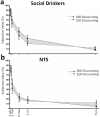Monetary discounting and ventral striatal dopamine receptor availability in nontreatment-seeking alcoholics and social drinkers
- PMID: 25563235
- PMCID: PMC4545519
- DOI: 10.1007/s00213-014-3850-5
Monetary discounting and ventral striatal dopamine receptor availability in nontreatment-seeking alcoholics and social drinkers
Abstract
Rationale: Dopamine (DA) in the ventral striatum (VST) has long been implicated in addiction pathologies, yet its role in temporal decision-making is not well-understood.
Objectives: To determine if VST DA D2 receptor availability corresponds with greater impulsive choice in both nontreatment-seeking alcoholics (NTS) and social drinkers (SD).
Methods: NTS subjects (n = 10) and SD (n = 13) received PET scans at baseline with the D2/D3 radioligand [(11)C]raclopride (RAC). Outside the scanner, subjects performed a delay discounting procedure with monetary rewards. RAC binding potential (BPND) was estimated voxelwise, and correlations were performed to test for relationships between VST BPND and delay discounting performance. Self-reported impulsivity was also tested for correlations with BPND.
Results: Across all subjects, greater impulsive choice for $20 correlated with lower BPND in the right VST. NTS showed greater impulsive choice than SD and were more impulsive by self-report. Across all subjects, the capacity of larger rewards to reduce impulsive choice (the magnitude effect) correlated negatively (p = 0.028) with problematic alcohol use (AUDIT) scores. Self-reported impulsivity did not correlate with BPND in VST.
Conclusions: Preference for immediate reinforcement may reflect greater endogenous striatal DA or lower D2 number, or both. Alcoholic status did not mediate significant effects on VST BPND, suggesting minimal effects from alcohol exposure. The apparent lack of BPND correlation with self-reported impulsivity highlights the need for objective behavioral assays in the study of the neurochemical substrates of behavior. Finally, our results suggest that the magnitude effect may be more sensitive to alcohol-induced problems than single discounting measures.
Figures




References
-
- Ayduk O, Mendoza-Denton R, Mischel W, Downey G, Peake PK, Rodriguez M. Regulating the interpersonal self: strategic self-regulation for coping with rejection sensitivity. J Pers Soc Psychol. 2000;79(5):776–792. - PubMed
-
- Berridge KC. The debate over dopamine's role in reward: the case for incentive salience. Psychopharmacology (Berl) 2007;191(3):391–431. - PubMed
-
- Bucholz KK, Cadoret R, Cloninger CR, Dinwiddie SH, Hesselbrock VM, Nurnberger JI, Jr., et al. A new, semi-structured psychiatric interview for use in genetic linkage studies: a report on the reliability of the SSAGA. J Stud Alcohol. 1994;55(2):149–158. - PubMed
Publication types
MeSH terms
Substances
Grants and funding
LinkOut - more resources
Full Text Sources
Other Literature Sources
Medical
Miscellaneous

